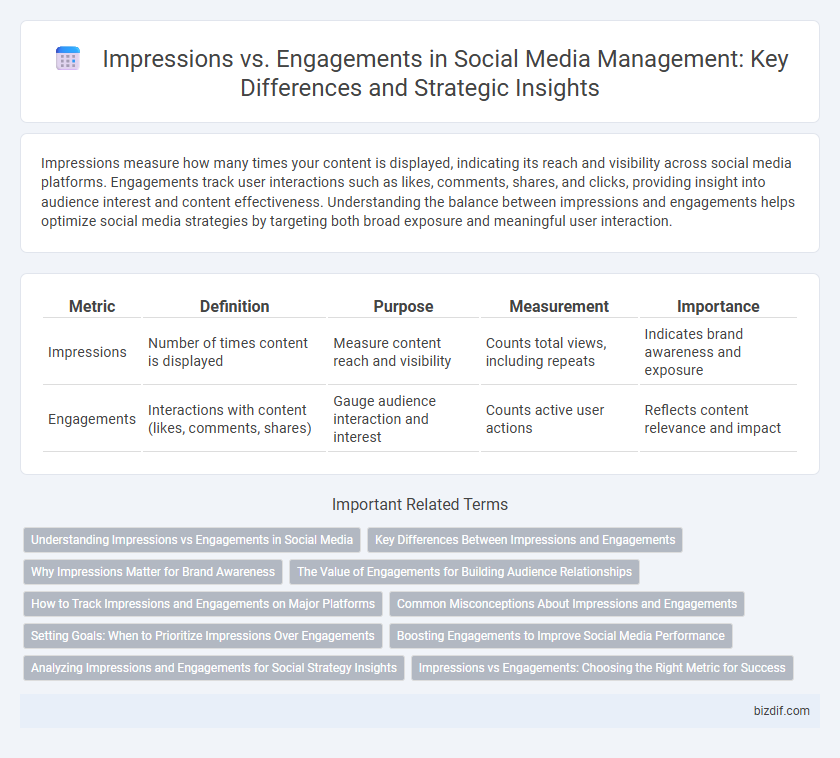Impressions measure how many times your content is displayed, indicating its reach and visibility across social media platforms. Engagements track user interactions such as likes, comments, shares, and clicks, providing insight into audience interest and content effectiveness. Understanding the balance between impressions and engagements helps optimize social media strategies by targeting both broad exposure and meaningful user interaction.
Table of Comparison
| Metric | Definition | Purpose | Measurement | Importance |
|---|---|---|---|---|
| Impressions | Number of times content is displayed | Measure content reach and visibility | Counts total views, including repeats | Indicates brand awareness and exposure |
| Engagements | Interactions with content (likes, comments, shares) | Gauge audience interaction and interest | Counts active user actions | Reflects content relevance and impact |
Understanding Impressions vs Engagements in Social Media
Impressions refer to the total number of times content is displayed on users' screens, indicating reach and visibility, while engagements measure meaningful interactions such as likes, comments, shares, and clicks that reflect audience involvement. High impressions with low engagements suggest content is seen but not compelling enough to provoke action, whereas balanced metrics indicate effective resonance with the target audience. Analyzing impressions versus engagements helps optimize social media strategies by identifying what types of content drive active participation and brand connection.
Key Differences Between Impressions and Engagements
Impressions refer to the total number of times a social media post is displayed, regardless of user interaction, while engagements measure the interactions such as likes, comments, shares, and clicks on that content. Impressions indicate the potential reach and visibility of a post, whereas engagements provide insight into audience interaction and content effectiveness. Understanding the distinction helps optimize social media strategies by balancing reach with meaningful user participation.
Why Impressions Matter for Brand Awareness
Impressions measure how often content is displayed, serving as a critical metric for brand visibility and reach on social media platforms. High impression counts increase the likelihood that diverse audiences will recognize and recall the brand, laying the foundation for deeper connections. Consistent impressions build familiarity, which boosts consumer trust and drives long-term brand awareness growth.
The Value of Engagements for Building Audience Relationships
Engagements provide deeper insights into audience interactions compared to impressions, reflecting likes, comments, shares, and clicks that indicate active participation. High engagement rates foster stronger community bonds, enhance trust, and drive brand loyalty by encouraging authentic conversations. Social media algorithms prioritize engaged content, increasing organic reach and reinforcing meaningful audience relationships over mere visibility.
How to Track Impressions and Engagements on Major Platforms
Tracking impressions and engagements on major social media platforms requires using built-in analytics tools such as Facebook Insights, Instagram Analytics, and Twitter Analytics. Impressions indicate how many times a post is displayed, while engagements measure interactions like likes, comments, shares, and clicks. Monitoring these metrics through platform-specific dashboards enables marketers to evaluate content performance and optimize social media strategies effectively.
Common Misconceptions About Impressions and Engagements
Impressions represent the total number of times content is displayed, but they do not indicate whether users interacted with the post, leading to common confusion between visibility and active participation. Engagements measure actual user interactions such as likes, comments, shares, and clicks, providing a clearer insight into content effectiveness and audience interest. Misinterpreting high impressions as success without considering engagement metrics can result in overestimating a campaign's impact and overlooking meaningful user connections.
Setting Goals: When to Prioritize Impressions Over Engagements
Setting goals in social media management requires prioritizing impressions when the focus is on brand awareness and reaching a broad audience, as impressions indicate how many times content is displayed. Impressions are crucial for campaigns aiming to maximize visibility, such as product launches or awareness drives, where exposure outweighs direct interaction. Engagements become secondary in these scenarios, as the primary objective is to introduce the brand or message to as many potential customers as possible.
Boosting Engagements to Improve Social Media Performance
Boosting social media engagements directly enhances audience interaction, increasing likes, comments, shares, and clicks that signal content value to algorithms. Unlike impressions, which only measure the number of times content is seen, engagements reflect active participation and deeper user interest, driving higher organic reach. Prioritizing engagement strategies like interactive posts, prompt responses, and compelling calls-to-action results in improved social media performance and stronger community building.
Analyzing Impressions and Engagements for Social Strategy Insights
Analyzing impressions and engagements provides critical insights for refining social media strategies by highlighting content reach versus audience interaction. High impressions with low engagement signal a need to improve content relevance or call-to-action effectiveness. Tracking these metrics enables data-driven decisions to optimize posting times, content types, and messaging for maximum audience connection and brand impact.
Impressions vs Engagements: Choosing the Right Metric for Success
Impressions measure the total number of times content is displayed, providing insight into brand visibility across social media platforms. Engagements track user interactions such as likes, comments, shares, and clicks, reflecting the audience's active involvement and content relevance. Choosing between impressions and engagements depends on campaign goals: prioritize impressions for brand awareness and engagements for building community and driving conversions.
Impressions vs Engagements Infographic

 bizdif.com
bizdif.com